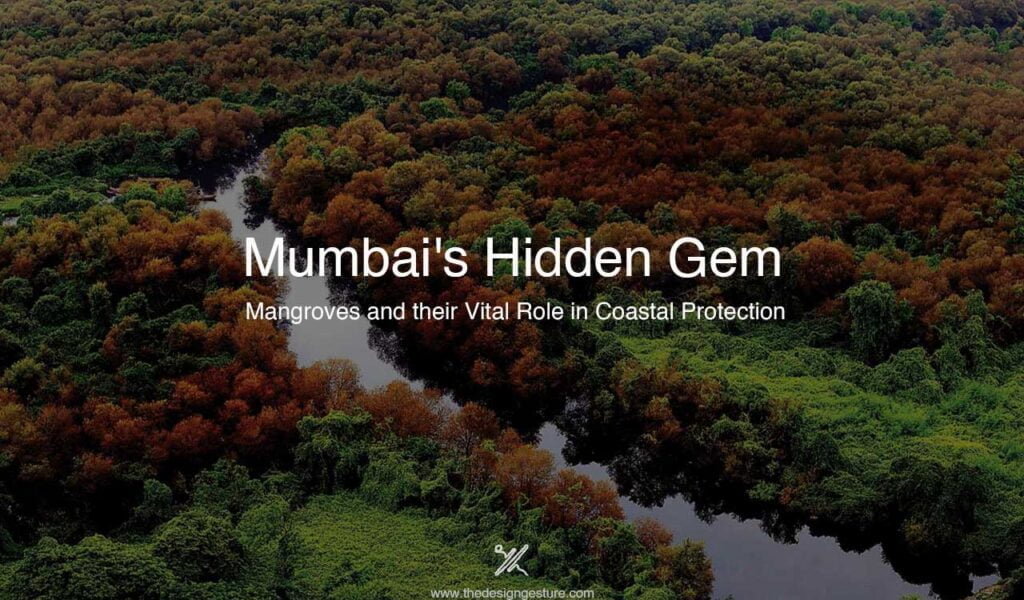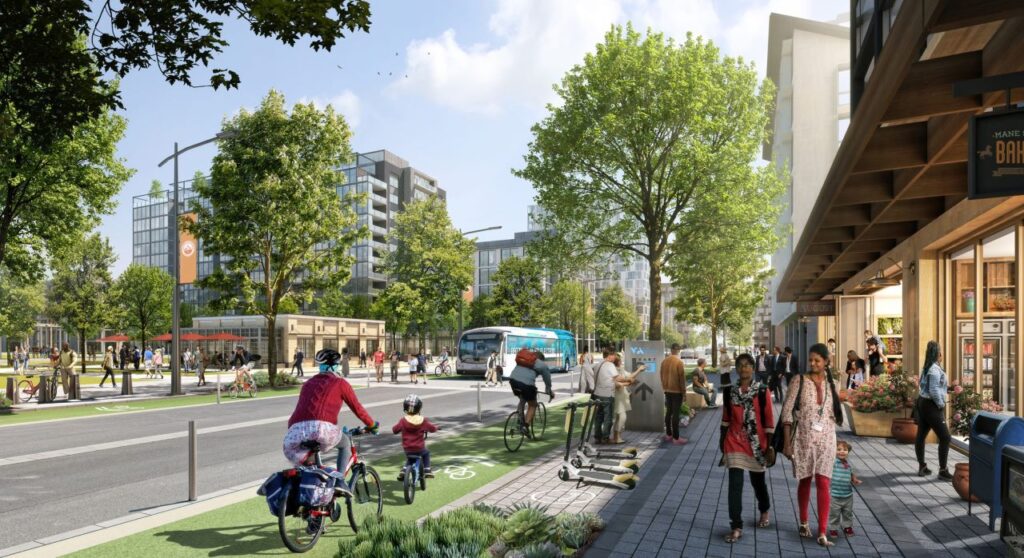Table of Contents
Introduction
Before its transformation into the bustling metropolis, that we recognize today as Mumbai, it was once a group of seven islands scattered across the Arabian Sea. As industrialization and development took hold, major land reclamation projects were initiated, and over time, these islands merged to form a single, expansive landmass.
Before the land reclamation, Mumbai had a diverse range of flora and fauna that thrived in the region. Being an island city, it was known for its vast mangroves covers that lined its coastline and intertidal water bodies. This unique ecosystem not only contributed to the city’s biodiversity but also served as a critical coastal defense mechanism against the forces of nature.

However, you may wonder what mangroves are and how they play a significant role in protecting Mumbai’s coast. Keep reading to find out.
What are Mangroves?
Mangroves are salt-tolerant thick, dark, and tree-like covers that grow at the interface between land and sea. Mangroves, as an integral part of the coastal ecosystem, protect coastlines, support biodiversity, and benefit local communities in a variety of ways.
Why are Mangroves important?
The dense root system of a mangrove helps to anchor the soil and prevent erosion, reducing the impact of coastal erosion and storms. Furthermore, they serve as natural barriers against tsunamis, cyclones, and storm surges, shielding cities from their destructive effects.
Mangroves not only provide economic benefits to local communities but also ecological benefits. They advocate for commercial fishing, and ecotourism as well as help play a significant role in reducing climate change.
Role of Mangroves in Mumbai
Mangroves play a vital role in Mumbai’s ecosystem and have a significant impact on the city’s environment, economy, and social well-being. Some of the essential roles of mangroves in Mumbai are:
1. Coastal protection: Mangroves act as a natural barrier against storm surges, tidal waves, and tsunamis, protecting the city’s coastline from erosion and flooding.
2. Biodiversity: The mudskipper, kingfisher, and horseshoe crab are just a few of the rare and endangered species that live in Mumbai’s mangroves.
3. Climate change mitigation: Mangroves absorb carbon dioxide from the atmosphere and store it in the soil and biomass, contributing to climate change mitigation.
4. Fisheries: The mangroves of Mumbai support the livelihoods of thousands of fishermen and their families by providing breeding and nursery grounds for various fish and shellfish species.
5. Tourism: The mangroves of Mumbai are a popular vacation spot for nature lovers and tourists because they offer opportunities for boating, kayaking, and birdwatching.
6. Water quality: Mangroves act as natural filters, trapping pollutants and sediments from the water and improving water quality.
Overall, mangroves in Mumbai are essential for the city’s ecological, social, and economic well-being and must be protected and conserved.
Degradation of Mangroves over the years
Mumbai’s mangrove enjoys the status of being older than the city itself. In the early 1600s, the Britishers recognized the commercial importance of joining the seven islands and initiated deforesting mangroves and reclaiming the land as one continuous landmass called “BOMBAY”. The extensive mangrove cover along the coastline and inland water bodies of Mumbai serves as the first line of defense against the sea. Moreover, mangroves provide a habitat for a diverse range of wildlife, including numerous species of birds, fish, and other aquatic creatures.
Mumbai has a long history of mangrove forests, as evidenced by the few remaining mangrove patches. At the moment, there are pockets of mangroves at Mahim and Gorai Creek, as well as along the coast in Versova, Sewri, Colaba, and Bandra. The coastal areas of Elephanta Island, Uran, Vashi, Vasai, Thane, and Bhyander creeks also comprise moderate mangrove patches in Mumbai.
Every year, coastal areas are subjected to frequent flooding as a result of the danger posed by rising sea levels and changing patterns of rain. In the last ten years or so, under the guise of building roads, sewage treatment plants, and garbage dumps, Mumbai has lost nearly 40% of its mangroves. Developing businesses and the release of modern and homegrown sewage are contaminating these regions in a way that is bringing about a decrease in the capacity of mangroves to absorb floodwater.
Mangrove forests are a vibrant ecosystem that harbors animal life, and migratory birds and serve as breeding areas for marine species
The Current Situation in Mumbai
The Mumbai Coastal Road Project
At present, major developments are underway in Mumbai with the construction of a coastal road project. The Mumbai Coastal Road Project is a proposed 35.6 km long freeway that will connect Marine Drive in South Mumbai to Kandivali in the north. The project aims to reduce travel time along the western coast of Mumbai and provide an alternative to the congested Western Express Highway.
The project has been divided into three parts, with each part being handled by a different contractor. The first phase involves the construction of a 9.98 km long stretch from Princess Street Flyover to the Worli end of the Bandra-Worli Sea Link. The second phase involves the construction of a 10.58 km long stretch from the Worli end of the Bandra-Worli Sea Link to Carter Road in Bandra. The third and final phase involves the construction of a 14.08 km long stretch from Carter Road in Bandra to Kandivali.
Impacts on the Environment
The project has faced opposition from some environmentalists and activists, who argue that it will harm the marine ecology and biodiversity of the coast. The project has faced negative reactions particularly due to concerns about its impact on mangroves. Mangroves are critical ecosystems that provide a range of benefits, including protecting coastal areas from storms and erosion.
As per reports, the construction of the coastal road is expected to affect around 9.98 hectares of mangrove forests, primarily in the southern part of the city. Environmentalists and activists have raised concerns that the construction could lead to the destruction of these mangroves, which could, in turn, have significant environmental and social consequences.
Restoring and improving the coastal biodiversity and mangrove cover along the coast of Mumbai is a complex and multifaceted issue that requires collaboration among various stakeholders.
Possible Solutions
The coastal road project and the restoration of mangroves are two interrelated problems because the road may affect the mangrove ecosystem. There are several ways for resolving this problem, including:
- Conduct an Environmental Impact Assessment (EIA) – Before beginning road construction, a potential impact on the mangrove ecosystem should be assessed through an EIA. The EIA ought to distinguish the likely dangers and propose measures to relieve them.
- Design the road to minimize impact – The road should be designed in a way that minimizes the impact on the mangrove ecosystem. This can be achieved by avoiding sensitive areas, using bridges instead of causeways, and minimizing the footprint of the road.
- Implement mangrove restoration – Mangrove restoration should be carried out to mitigate the road’s negative impact on the mangrove ecosystem. The water quality can be improved and sedimentation can be reduced by planting new mangroves in areas where they have been destroyed.
- Educate the local community – The local community should be educated about the significance of the mangrove ecosystem and the road’s potential effects. This can be accomplished through community gatherings, workshops, and public awareness campaigns.
- Monitor the impact – The road’s effect on the mangrove ecosystem should be regularly monitored. This will enable corrective action and assist in identifying any potential issues.
Conclusion
In conclusion, conserving and rehabilitating the mangroves that line Mumbai’s coast is crucial to the preservation of biodiversity and the prevention of natural disasters. It is a challenging issue that requires collaboration with a number of stakeholders, including local communities, non-governmental organizations, the private sector, and the government.
Mangrove forests must be protected and restored through regular monitoring, public education, the implementation of restoration and conservation programs, and the encouragement of sustainable development practices.
We can guarantee the coastal ecosystem’s long-term viability by striking a balance between economic growth and environmental preservation. The biological system, as well as individuals whose jobs, well-being, and prosperity rely upon mangrove forests, will profit from their security and rebuilding. It is a critical investment in the future of Mumbai’s coastline, and we must take action now to ensure its long-term sustainability.




